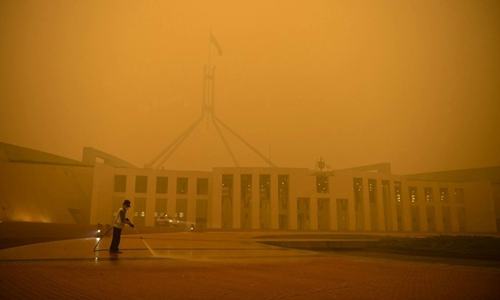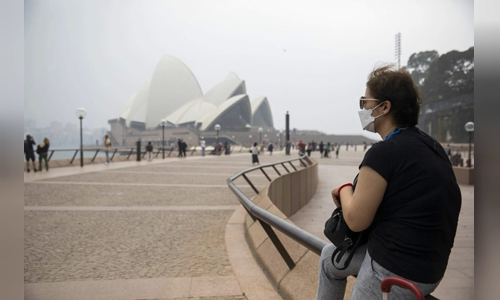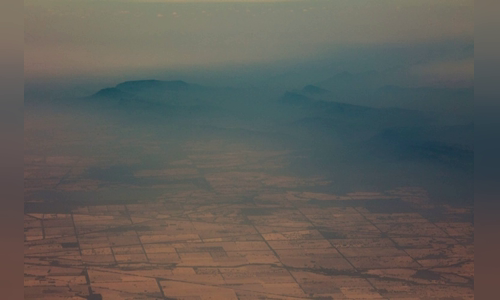Jenny Edwards did not want to go home to Canberra. She extended the family holiday by 7 days to "avoid smoke" but it didn't help much.
Just one day after returning, Edwards's eyes were irritated, his chest was stuffy, his head ached and his throat always felt itchy, causing her to cough endlessly. Three great wildfires still flared 100 km away. Canberra's air quality during the New Year has been one of the worst cities in the world.

Forest smoke smothered the Australian parliament building in Canberra on January 5 Photo: Reuters
Forest fires have polluted a large area of Australia, affecting hundreds of thousands of people. Emergency calls, ambulances and emergency rooms at the hospital have increased dramatically recently. Some government agencies have even closed.
Numerous supermarkets, shops without smoke masks for sale and the government have recently begun distributing masks to particularly vulnerable people such as pregnant women, the elderly, people with heart disease and lung disease.
On Facebook, people competed to post pictures of themselves using tape to seal doors and windows to prevent smoke from entering the home.
A question posed to the most serious wildfires in Australian history last year to date is: How will people's health be affected in the long run when they are exposed to too much smoke? .
According to the researchers, the smoke of the forest not only affects the skin and eyes, it also enters the mind, haunts their thoughts, and affects mental health. This is a study in Victoria after the "Black Saturday" fire in 2009.
"I expect the effect to be much greater than before because the fires have lasted so long," said Mirella Di Benedetto, clinical psychologist at RMIT University in Melbourne.
The fires in 2009 left Victoria isolated, but now fires across the country, near Australia's largest cities. "The smoke has even spread to places without fire," Di Benedetto said. "The air quality in Sydney is really bad. I think the impact on mental and physical health will be terrible in the coming months."

A masked woman sits near the Sydney Opera House on January 8 Photo: Bloomberg News
In Australia, smoke affects cities in unexpected ways. At a Canberra public hospital, employees had to close the doors to prevent smoke from entering the hallway and the hospital room, said emergency room physician David Caldicott.
Some nurses, wearing oxygen masks and smoke, paralyzed many MRI MRI scanners. At Caldicott's home, the smoke alert sensor constantly triggered the fire alarm, forcing him to cover it with a towel.
In New South Wales, where Sydney is located, health officials say the number of people transferred to the emergency room for asthma and breathing problems increased 34% between December 30 and January 5 compared to January 30. with the same period last year. The number of emergency calls for respiratory problems is also high, about 2,500 compared to the five-year average of 1,900. The number of hospitalizations increased to over 430, while the 5-year average was 361.
Four of Australia's five largest population centers are suffering from the impact of wildfires. At least 25 people were killed, nearly 2,000 houses were destroyed and more than 5.6 million hectares of forest were burned. Smoke was born so much that it spread to South America.
Fires are a major cause of asthma attacks, noted Bruce Thompson, head of the Department of Health Sciences at Swinburne University of Technology in Melbourne. "This is a very serious health issue," he said.
Fine particles of 5 micrometres will "stick to your nose, leaving you with a runny nose and itchy eyes when you wake up," Thompson said. "Fine particles of 2.5 micrometers or PM 2.5 are even scarier. They can go all the way to the lungs. We saw a coal mine fire and then four years later, the lungs of the children living nearby." where the fire is greatly weakened.
According to Thompson, developing lungs in children can be permanently damaged to varying degrees.

Haze covered the Cooma Mountains in New South Wales on January 7 Photo: AFP
"The lungs will become inflamed and make you cough," Thompson said. "The lung is very bad at healing itself. It will try to remove fine particles by making you cough, but this will create scar tissue and you don't want scarring in your lungs because it reduces the effectiveness of lung".
Fay Johnston, an environmental health professor at the Medical Research Institute at the University of Tasmania, said most people exposed to smoke would not be harmed if the fires soon went out. "If the smoke clears, healthy people can tolerate it," said Johnston. "Healthy people will survive without long-term injuries."
However, the rainy season in Australia will not start before February. Like many other researchers, Johnston is concerned about the unpredictable effects on the elderly and people with asthma if the fire continues. "We really don't know what its long-term sequelae is," she said.
Meanwhile, in Bowral, south of Sydney, Peggy Stone says she is fighting every day to fight depression and pessimism. "We haven't seen the Sun for weeks," Stone said. The sky was orange when it turned gray.
Farther south in Canberra, Jenny Edwards, who has asthma, has scheduled a doctor visit.
"I am very worried about the future in the next few months," she shared. "It is difficult to predict what the air quality will be like when there are still large fires in our area and there is a possibility that a new fire will start." Edwards was thinking of leaving Canberra, but she knew this option was extremely risky because the fire could spread anywhere.



 VirginiaLaFriedaOsonitsch
VirginiaLaFriedaOsonitsch







